
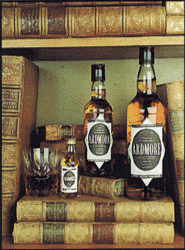
Ardmore is not widely known as a single malt, but its qualities as such were endorsed earlier this year when it received recognition as ‘highly recommended‘ in a Blind Panel Tasting held by De-canter Magazine. With its pungent peaty taste, Ardmore has always been a vital element in a famous and distinguished blended Scotch Whisky, Teachers Highland Cream and, as we discovered during our visit to the distillery, almost all of its production does actually go for blending. Fortunately, with the authority of the distillery owners, Allied Distillers, some of this distinctive whisky is bottled and sold as a single malt by Gordon & MacPhail.
Ardmore comes from a distillery set deep in the hills of Aberdeenshire, close to the village of Kennethmont. The rolling hills in this area are covered with fertile farm land. The elegant National Trust Leith Hall is situated on the outskirts of Kennethmont and the main railway line from Inverness to Aberdeen runs beside the distillery itself.
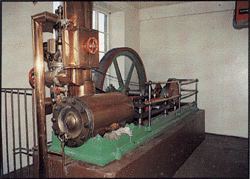 It
was William Teacher’s son, Adam who organised the
construction of Ardmore in 1898. These were the years when there
was a boom in the whisky industry. Over the intervening years
Ardmore has continued to prosper and is now one of the larger and
most modern Scotch Whisky distilleries, with a total capacity
reaching some three million litres.
It
was William Teacher’s son, Adam who organised the
construction of Ardmore in 1898. These were the years when there
was a boom in the whisky industry. Over the intervening years
Ardmore has continued to prosper and is now one of the larger and
most modern Scotch Whisky distilleries, with a total capacity
reaching some three million litres.
Walking around the distillery, there are a great many reminders of the past. The original steam engine, that used to power the whole operation, still stands proudly gleaming, somewhat incongruous, behind the modern malting plant used to grind the grain. Mounted on the wall in the Mash Room, is the side plate of the distillery’s original mash tun, while the walls of the Manager’s office are decorated with the portraits of the original workforce.
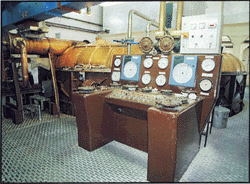 When the
distillery was established and for many years thereafter,
supplies of barley and coal were transported to the distillery by
rail. The distillery had its own siding which was also used to
load the casks of mature whisky when they were being dispatched
to Teachers in the south. Today some of the buildings which
formed the station still stand and mark a bygone era.
When the
distillery was established and for many years thereafter,
supplies of barley and coal were transported to the distillery by
rail. The distillery had its own siding which was also used to
load the casks of mature whisky when they were being dispatched
to Teachers in the south. Today some of the buildings which
formed the station still stand and mark a bygone era.
Ardmore draws its water from 14 springs on the Knockandy Hill, which lies to the south of the distillery, cooling water comes from the burns nearby. Until the late 1970s, barley was malted at the distillery itself, but in recent years supplies have come from local commercial maltsters. The fuller more pungent flavour of the whisky produced here, in contrast to many other Highland malts, is due to the relatively high peating levels of the barley.
Malt storage is about 1,000 tonnes and the traditional copper domed mash tun of a notable 25 feet in diameter mashes 12.0 tonnes. There are 14 wooden wash backs, which have a total capacity of 90,000 litres. The wash remains here for approximately 48 hours until the fermentation process is complete and is then fed to the four wash stills.
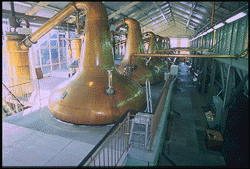 Ardmore was initially built with two stills, it was extended in
1958, when a further two stills were added. In 1975, the capacity
was doubled with another four stills, all copies of the original
stills. The still room today is the distillery’s pride and
joy and the reasoning for this becomes self-evident. Viewed from
the high-level entrance to the still room, the stills present a
magnificent sight - a row of eight elegantly shaped copper
stills, each with an equal capacity of 15,000 litres. The spirit
stills vary slightly in shape from the wash stills in that they
have a slightly taller neck.
Ardmore was initially built with two stills, it was extended in
1958, when a further two stills were added. In 1975, the capacity
was doubled with another four stills, all copies of the original
stills. The still room today is the distillery’s pride and
joy and the reasoning for this becomes self-evident. Viewed from
the high-level entrance to the still room, the stills present a
magnificent sight - a row of eight elegantly shaped copper
stills, each with an equal capacity of 15,000 litres. The spirit
stills vary slightly in shape from the wash stills in that they
have a slightly taller neck.
 One of the most striking factors about this still room, however,
is that the stills are heated in the traditional manner, direct
with coal furnaces. This is quite unusual as there are not many
distilleries remaining now which use coal. The stills have thick
bases and chain rummagers inside which stop the content from
burning. The condensors are situated inside the still house and a
heat recovering system has been in operation for many years.
One of the most striking factors about this still room, however,
is that the stills are heated in the traditional manner, direct
with coal furnaces. This is quite unusual as there are not many
distilleries remaining now which use coal. The stills have thick
bases and chain rummagers inside which stop the content from
burning. The condensors are situated inside the still house and a
heat recovering system has been in operation for many years.
The old distillery maltings have been converted into a filling store. Casks are stored in the extensive warehouses which are adjacent to the distillery.
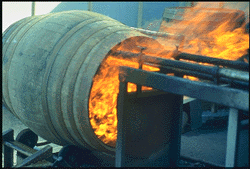 From the old maltings, our tour took us to the cooperage -
another memorable part of our visit to Ardmore. The distillery
has its own cooperage, where casks are prepared prior to filling
with new whisky. On occasions this entails the firing or
char-ring of the inside of the cask to help with the maturing of
the whisky.
From the old maltings, our tour took us to the cooperage -
another memorable part of our visit to Ardmore. The distillery
has its own cooperage, where casks are prepared prior to filling
with new whisky. On occasions this entails the firing or
char-ring of the inside of the cask to help with the maturing of
the whisky.
The fact that Ardmore is very much a traditional distillery was evident throughout our visit - even to the point of the customary distillery cat - this one being three legged - warming itself by the heat of the glowing coals in the still room. But perhaps the reminders of the past that are found all over the distillery are significant in so far as they suggest a continued commitment to the quality of fine malt that has been produced there for so many years.
Read our tasting notes for Ardmore Whisky.
Home | History | Sample Room | News | Product Range | Shop